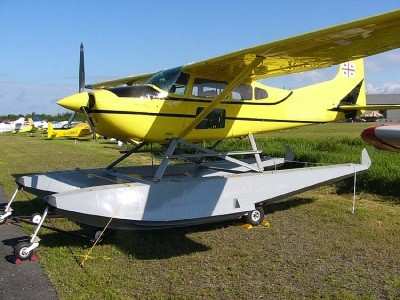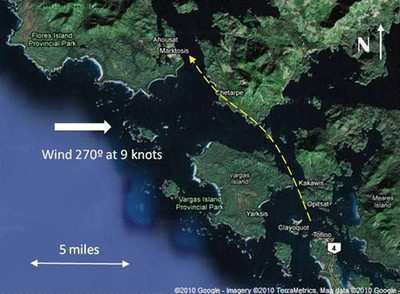Transportation Safety Board of Canada Said Passengers Were
Intoxicated During The Flight
 The Transportation Safety Board (TSB) of Canada has released
its final report from the investigation of an accident in which the
pilot of a floatplane and three passengers were fatally injured
when the plane went down in the water. The board said it was likely
that an intoxicated passenger interfered with the operation of the
aircraft.
The Transportation Safety Board (TSB) of Canada has released
its final report from the investigation of an accident in which the
pilot of a floatplane and three passengers were fatally injured
when the plane went down in the water. The board said it was likely
that an intoxicated passenger interfered with the operation of the
aircraft.
According to the TSB, the Atleo River Air Service float-equipped
Cessna 185F (serial number 18503618, registration C-GIYQ), took off
from Tofino, British Columbia, at 1200 Pacific Daylight Time for a
flight to Ahousat, with a pilot and three passengers. The short
flight was being carried out under visual flight rules at about 500
feet above sea level. About two nautical miles from Ahousat, while
in cruise flight, the aircraft descended in a steep nose-down
attitude until it hit the water in Millar Channel and overturned.
Attempts to secure the aircraft failed and it sank. There were no
survivors. The emergency locator transmitter functioned but its
signal was not received until the wreckage was brought to the
surface two days later.

Cessna 185F File Photo
The aircraft had been chartered by three residents of Ahousat.
They had a small amount of baggage and cargo that consisted of
several bottles of liquor, a case of beer, and some personal
effects. It is unknown where the baggage and cargo were stowed in
the aircraft, but they were not secured.
The passengers were intoxicated, however they were able to walk
and were sufficiently coherent to argue about the price of the
charter.
Divers found the aircraft wreckage resting on the ocean floor
with all the occupants still inside. The pilot was restrained by
the lap seat belt; all of the passengers were unrestrained. The
right door was ajar. Post-recovery examinations of the wreckage
revealed damage indicative of the aircraft striking the water at an
attitude of about 45° nose down and the right wing low. There
were no indications of control malfunctions. All the control cables
were correctly routed and in working condition. The pulleys, trim
jacks, and all other control fittings showed no evidence of
pre-impact damage. The elevator trim was set at about 5° nose
down 1 and the flaps were fully retracted. The aircraft was
configured for cruise flight. There was no evidence of engine
malfunction. The propeller also showed no evidence of pre-impact
malfunction, and it sustained damage consistent with significant
power at impact. The engine controls were pushed through the
instrument panel and badly damaged from collision forces.

Route of Flight TSB Canada Image
Pieces of the cardboard beer case and the remnants of several
beer cans were found behind the instrument panel, having penetrated
near the engine controls. The V brace, which forms a V between the
top corners of the windshield and the top centre of the instrument
panel, was bent forward.
Tests were done to determine if the passengers could have
interfered with the aircraft's controls, or the pilot's ability to
control the aircraft.
These tests revealed that a person in the passenger front seat
can place a foot onto the control system under the instrument panel
and push the control column forward, thereby causing a nose down
control input. In this scenario, however, the pilot can easily
overcome the interference.

Pilot Forced Into Controls TSB Canada Image
It was also found that if the pilot's upper body is not secured
by the shoulder harness, a rear passenger could push the pilot's
seatback forward causing the pilot to push the control yoke
forward, thereby causing a nose down control input. It was noted
that the pilot had no space to leverage his arms and push back
sufficiently to overcome the passenger's leg force from behind. In
this scenario, a pilot could not resist a push from the back unless
it was expected and the pilot braced accordingly.
According to the TSB, it is likely that passenger interference
caused the pilot to lose control of the aircraft whereupon it
descended in a steep nose-down attitude until it struck the water.
It is also possible the passengers' level of intoxication
contributed to their inability to recognize the gravity of the
situation and stop the interference in time for the pilot to regain
control of the aircraft before impact. Because there was no locking
mechanism on the pilot's seatback, and because the pilot was not
wearing his shoulder strap, he would have been unable to prevent
his upper body from being forced onto the instrument panel.
 SpaceX to Launch Inversion RAY Reentry Vehicle in Fall
SpaceX to Launch Inversion RAY Reentry Vehicle in Fall Aero-News: Quote of the Day (04.23.24)
Aero-News: Quote of the Day (04.23.24) Aero-News: Quote of the Day (04.20.24)
Aero-News: Quote of the Day (04.20.24) ANN's Daily Aero-Linx (04.20.24)
ANN's Daily Aero-Linx (04.20.24) Aero-News: Quote of the Day (04.21.24)
Aero-News: Quote of the Day (04.21.24)





